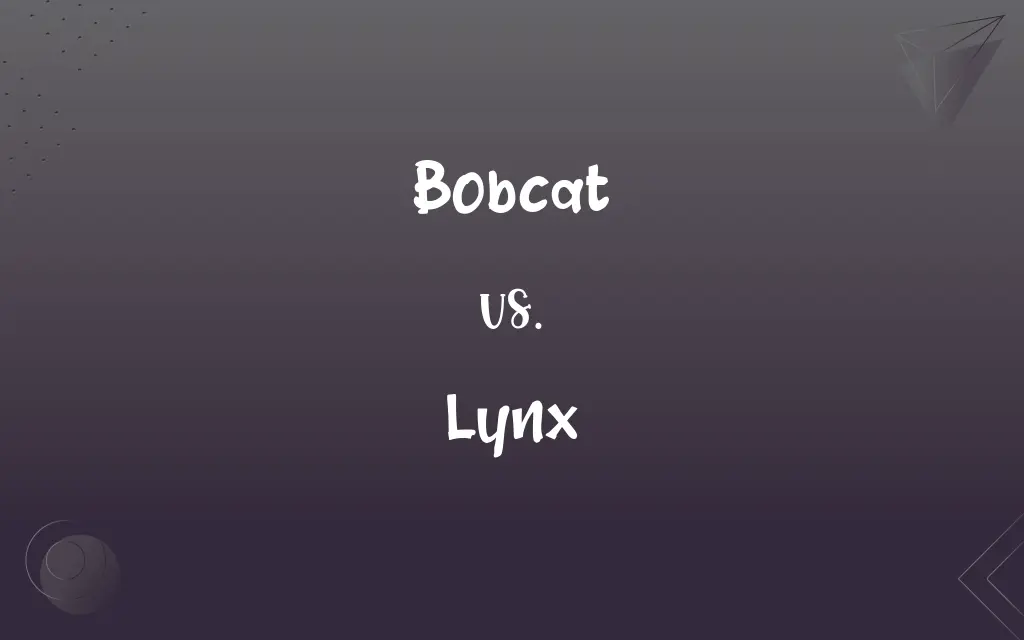Bobcat vs. Lynx: What's the Difference?
Edited by Aimie Carlson || By Harlon Moss || Updated on October 25, 2023
Both are wild cats, but bobcats are smaller and have shorter ear tufts, while lynxes have longer legs and larger paw pads.

Key Differences
The bobcat, often found in North America, is named for its short, bobbed tail. The lynx, on the other hand, is a term that encompasses several species, including the Eurasian lynx, which is much larger than the bobcat.
When observing the physical characteristics, bobcats tend to have spotted coats, helping them blend into various terrains. Lynxes, especially those found in colder climates, possess thicker fur, larger paw pads, and longer legs, all adaptations to snowy environments.
Another distinguishing feature is the ear tufts. While both the bobcat and lynx have tufted ears, the lynx's tufts are notably longer. This feature, along with its larger paw pads, gives the lynx a distinct appearance.
In terms of habitat, the bobcat is more adaptable, found in forests, swamps, and even suburban areas across North America. The lynx, conversely, primarily dwells in northern forests throughout Canada, Europe, and Asia, thriving in regions with thick underbrush and ample prey.
When considering their diet, bobcats primarily prey on rabbits, birds, and rodents. Lynxes, specifically the Canada lynx, have a diet heavily dependent on snowshoe hares, making their population dynamics closely tied to hare abundance.
ADVERTISEMENT
Comparison Chart
Geographical Range
Primarily North America
Canada, Europe, and Asia
Physical Features
Spotted coat, shorter ear tufts
Thicker fur, long ear tufts, larger paw pads
Size
Generally smaller
Larger, especially the Eurasian lynx
Habitat
Forests, swamps, suburban areas
Northern forests with thick underbrush
Diet
Rabbits, birds, rodents
Heavily dependent on snowshoe hares (for the Canada lynx)
ADVERTISEMENT
Bobcat and Lynx Definitions
Bobcat
A medium-sized wildcat native to North America.
The bobcat left tracks near the campsite.
Lynx
Primarily a solitary predator with a specialized diet.
The Canada lynx's survival is closely linked to the abundance of snowshoe hares.
Bobcat
Known for its short "bobbed" tail and tufted ears.
She noticed the distinct tail of the bobcat as it crossed the road.
Lynx
Possesses a thick coat that varies in coloration based on species and region.
The lynx's fur was a beautiful shade of gray, ideal for blending into its surroundings.
Bobcat
Adaptable predator found in varied habitats across its range.
Despite the urban expansion, the bobcat has found ways to survive.
Lynx
A wildcat with a preference for colder, northern habitats.
The lynx moved silently through the snowy forest.
Bobcat
A wildcat with a spotted coat that aids in camouflage.
The bobcat's coat blended seamlessly with the fall foliage.
Lynx
Encompasses several species, including the Eurasian and Canada lynx.
The Eurasian lynx is one of the largest predators in Europe.
Bobcat
A carnivorous feline that preys on smaller animals.
The bobcat stealthily approached its prey.
Lynx
Recognized by its long ear tufts and large paw pads.
The distinguishing ear tufts made it clear it was a lynx.
Bobcat
A wild cat (Lynx rufus) of North America, having spotted reddish-brown fur, tufted ears, and a short tail. Also called bay lynx.
Lynx
Any of several wildcats of the genus Lynx, especially L. canadensis of northern North America or L. lynx of Eurasia, having soft thick fur, a black-tipped short tail, and tufted ears.
Bobcat
A North American wildcat, Lynx rufus, having tufted ears and a short tail.
Bobcat
A multi-purpose construction vehicle, akin to a smaller version of a front-end loader or a backhoe (backhoe loader), with a one-man caged control cabin.
Bobcat
Small lynx (Lynx rufus) of North America.
Bobcat
Small lynx of North America
FAQs
Are lynxes larger than bobcats?
Yes, especially the Eurasian lynx, which is notably larger than the bobcat.
In which type of environment is the bobcat most adaptable?
The bobcat is adaptable to various environments, from forests and swamps to suburban areas.
What is the primary geographical range of the bobcat?
The bobcat is primarily found in North America.
Is the bobcat's tail distinctive?
Yes, the bobcat has a short, "bobbed" tail, which gives it its name.
How does the coat of a bobcat look?
The bobcat typically has a spotted coat aiding in camouflage.
What makes the bobcat's habitat versatile?
Bobcats are highly adaptable, allowing them to inhabit a wide range of environments.
Which cat has a thicker fur coat, the bobcat or lynx?
The lynx typically has a thicker fur coat, especially those in colder climates.
Can both bobcats and lynxes be found in North America?
Yes, both species are found in North America, but they inhabit different ranges.
Is the bobcat the only wildcat with a "bobbed" tail?
While the bobcat is notably recognized for its short tail, other wildcats may also have shorter tails.
Do lynxes have longer ear tufts than bobcats?
Yes, lynxes generally have longer ear tufts compared to bobcats.
What is a primary prey for the Canada lynx?
The Canada lynx primarily preys on snowshoe hares.
Are there different species of lynxes?
Yes, there are several species, including the Eurasian lynx and Canada lynx.
How does the diet of a bobcat vary from that of a lynx?
While bobcats have a varied diet including rabbits, birds, and rodents, the Canada lynx is especially dependent on snowshoe hares.
In which regions are lynxes primarily found?
Lynxes are primarily found in northern forests across Canada, Europe, and Asia.
Are lynxes solitary animals?
Yes, lynxes are typically solitary predators.
What's a primary feature to identify a lynx?
One primary feature of the lynx is its long ear tufts.
How does the bobcat's adaptability aid in its survival?
The bobcat's ability to inhabit diverse environments, even near urban areas, aids its survival.
Is the Eurasian lynx the only lynx species in Europe?
The Eurasian lynx is the primary species in Europe, but there are other lynx species globally.
Do both bobcats and lynxes have tufted ears?
Yes, both species have tufted ears, but the lynx's are generally longer.
Are both bobcats and lynxes carnivorous?
Yes, both the bobcat and lynx are carnivorous predators.
About Author
Written by
Harlon MossHarlon is a seasoned quality moderator and accomplished content writer for Difference Wiki. An alumnus of the prestigious University of California, he earned his degree in Computer Science. Leveraging his academic background, Harlon brings a meticulous and informed perspective to his work, ensuring content accuracy and excellence.
Edited by
Aimie CarlsonAimie Carlson, holding a master's degree in English literature, is a fervent English language enthusiast. She lends her writing talents to Difference Wiki, a prominent website that specializes in comparisons, offering readers insightful analyses that both captivate and inform.































































